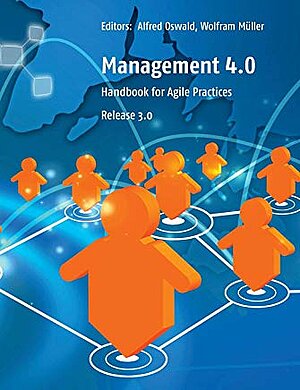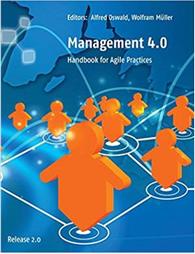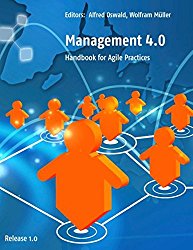Sie befinden sich hier > Management 4.0
Management 4.0 - Handbook for Agile Practices, Release 3
Management 4.0, Release 3 of our Handbook for Agile Practices, contains the following new or revised chapters:
Agile Leadership 4.0 – Digital Network Intelligence
Summary: Digital communication is a key driver for changing industry dynamics. Information can be shared and collaboration can be organised in a much quicker and more effective manner than in traditional analogue culture. However, digital tools have the potential to store information and actions indefinitely, resulting in ever-lasting accountability. In addition, digital environments do not currently address how to build trust and how to convey emotions. Communication and collaboration in this environment takes place within a horizontal network with a reduced or non-existent hierarchy. This necessitates a game-changing management approach. But what is it that really enables these digital networks? Why do they so often break apart before being established and sustained? And how do leaders position themselves in these new business environments with free flow of information and self-organization? One major prerequisite for success lies in the hands of the management, who can proactively create the right framework for self-organised communication. The conditions for an Agile Management System, which enables Digital Network Intelligence, need to be defined, those involved need to be committed via strategic exercises, and digital networks have to be lived and experienced accordingly.
Key Terms: Digital Networks, Horizontal Communication, Agile Management Systems, Corporate Mindset, Governance, Network Intelligence, Enterprise Social Networks (ESN)
Scaled Agile Management 4.0
Summary: The scaling of an Organization, especially an Agile Organization, is characterized by first principles. Three scaling principles and the principle of self-organization allow a better understanding of organizational scaling and the characterisation of “off-the-shelf” scaling frameworks. Scaled Agile Management 4.0 integrates these insights into a meta-framework of agile scaling.
Key terms: Scaling, Sublinear Scaling, Linear Scaling, Superlinear Scaling, Team of Team, Agile Organization, Conventional Organization, Scaling Principles, Fractal, Invariant Ends, Impedance Match, Collective Mind Team Effect, Self-organization, Hierarchy Representation, Circle Representation, SAFe, LeSS, Holacracy, CCPM
Agile Transformation 4.0
Summary: Agile Transformation 4.0 is based on a four-phase cognitive PDCA Transformation. In contrast to changes and transitions, transformations accept fuzziness in all aspects. We outline the relationship to methods like Design Thinking or Theory U. The Theory of Transformation and its related interventions are based on recent scientific insights. We summarize the key characteristics of Agile Transformation 4.0 using a transformation example.
Key Terms: Change, Transition, Transformation, Collective Mind, Learning Organization, Design Thinking, Theory U, Neuro Linguistic Programming (NLP), Dilts Pyramid, PDCA Cycle, Cognitive Bias, Tipping Point, Social Network, Social Contagion, True and False News, Theory of Change, Business Model Canvas, Governance
Learnings and Guidance for the Implementation of Agility
Summary: This chapters discusses a selection of potential “fuckups” that may occur when implementing agility in an organization. The fuckups and the aim for the sweet spot of agility, will hopefully provide a practical guidance during the move to agility.
Key Terms: Agility, Fuckups, Social Romanticism, Agile Dogmatism, Agile Scaling, Agile Governance
Interaction Patterns for the Digital Transformation
Summary: We will illustrate that the mindsets of individuals or the prevailing mindset of a population or part of a population are sources of a communication marco-structure. Digitization is a context which modulates this macro-structure, resulting in digitization-specific interaction patterns. For the prevailing mindsets we propose four different Personality Archetypes with different interaction patterns. We outline potential intervention techniques for initiating a successful Digital Transformation.
Key Terms: Digitization, Digital Transformation, Self-organization, Setting Parameter, Control Parameter, Order Parameter, Persona, Personality Archetype, Value-mem, Spiral Dynamics, Learning Level, Micro-tier, Macro-tier, Macro-structure
Management 4.0 - Handbook for Agile Practices, Release 2.0
Das Release 2.0 des Handbuches der GPM Fachgruppe Agile Management ist im März 2018 erschienen, mit folgenden neuen Kapiteln:
- Principles of Agile Leadership 4.0
- Agile Leadership 4.0 - Digital Network Intelligence
- Reference Model Agile Organizations
- Agile PMO 4.0
Management 4.0 - Handbook for Agile Practices: A Minimal Viable Product
One of the most important agile principles is to get feedback from customers as quickly as possible!
The book is not yet finished, and we still have enough material remaining for further releases – there is so much more to write and say. So much so, that it would be easy to keep working on the book for an infinite amount of time.
However, we believe that this release – contains enough to be of value for you as reader. Your feedback is of great importance to us – it will help us to improve quickly!
We have created a product backlog in the book, which contains the topics we have planned for the next release of the handbook. We intend to change the content and priorities of the topics depending on the feedback we receive from you.
So feel free - after reading the book – to discuss your ideas with us. You can contact us at: agile-management@gpm-ipma.de.
Management 4.0 - Handook for Agile Practices, Release 1.0
Who should read this Book?
This book is written for anyone who is interested in agility or needs to be agile. It is for those who seek deeper knowledge about what keeps the agile world together. You can read it from the perspective of a top manager or decision maker who feels the urge to be more agile. But you can also take the book and just follow it from the perspective of a user.
What do you get?
- A systemic picture of agility – to enable you to analyze your system (your team, your department, your company or your business network) and identify fields of agile application and the specific need for agility.
- The ingredients of an agile mind-set – this allows you to transform your organization and develop an agile culture for your organization.
- The theoretical foundation of agile principles – so that you can really understand and assess the value of all the expert ideas for you and your organization. You will get the necessary skills to tailor organization specific agile frameworks without losing essential ingredients.
- Input for your own reflections – you will be capable of innovating agility and be ahead of the main stream.
The Principles behind the Book?
We illustrate the big picture of the concept of the book by roughly outlining the content of Release 1:
PART 1 FOUNDATION
In Part I FOUNDATION we start with an outline of one of the main drivers of complexity, the megatrend “digitization” followed by short reasoning of the name “Management 4.0” for this book.
We then go on to explain the basic principles of Management 4.0:
- the key principles of an agile mind-set and the link to Management 4.0
- the relationship of agility and complexity
- the “definition” of hybrid (project) management
- the basics of self-organization
- the key principles of the agile frameworks Scrum and Kanban from the perspective of Management 4.0
- the relationship between cybernetics and agility and derive guidelines for the design of agile and fluid organizations
- the relationship to lean management and the IPMA project excellence model ICB 4.0
PART II BECOME AGILE AND STAY AGILE
In Part II BECOME AGILE AND STAY AGILE we start with the chapter “Agile Radar”, which gives a description of a tool that can be used to explore organizational agility needs, capabilities and potentials.
With the help of the “Agile Radar” we
- provide the reader with an agility assessment of their organization
- explain which agile methods and enablers to use, and when and how
- show (the first) blueprints for agile transformation (in Release 2, see above)
We then describe the impact of agile working on human resource issues.
We outline the “Reliable and Ultimate Scrum” agile frameworks as examples of how agile principles can be applied, and give input to the discussion on agility and fixed price contracts.
In the chapter “Agile Scaling”, we outline the Scaled Agile Framework SAFe and the Critical Chain Project Management method.
PART III AGILE MANAGEMENT IN PRACTICE
Part III AGILE MANAGEMENT IN PRACTICE is devoted to practical examples of Management 4.0.
Aktuelles
Unsere Seminarprogramm haben wir auf Seminare nach Vereinbarung umgestellt: Zum Seminarprogramm!
Blog Management 4.0, Theorie und Praxis
Neuer Eintrag 'Quantum Spiral Dynamics: ‚Es gibt nur eine Welt!‘ – Computer-experimentelle Metaphysik oder von Kohärenz und Kohäsion' in meinem Blog Management 4.0
Kontakt
IFST - Institute for
Social Technologies GmbH
Weißdornweg 12
52223 Stolberg
Deutschland
Tel.: +49 (0)2402 37011
info(at)socialtechnologies.de




